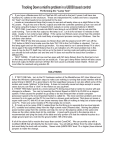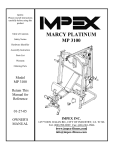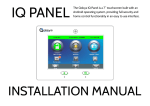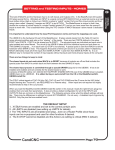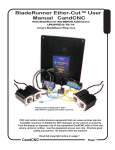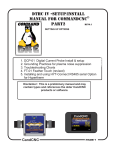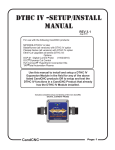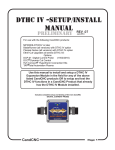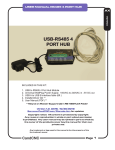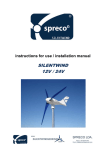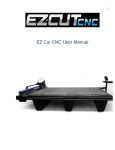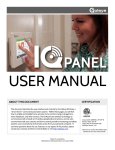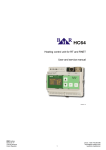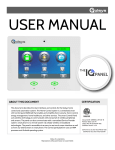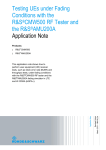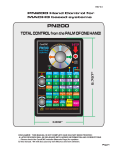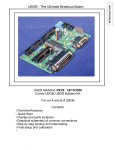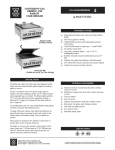Download Ohmic Sensor Install-Setup Manual
Transcript
CandCNC 1.627" FeatherTouch Ohmic Sensor WARNING Use with Floating Torch Only Power SENSE FeatherTouch™ Ohmic Sensor for CandCNC BladeRunner. Plazpak and MP3000-DTHC(II) units. For REV1 & REV2 Units OUT IN FRONT SIDE VIEW 2.502" MANUAL RELEASE 5 4 OUT 6 5 4 321 3 2 1 21 Z HOME NC COM + DC LIMITS - DC Limit String Z IN Switch Plate Tip (WC) If your lable shows TIP as 2 and Plate as 1, it is WRONG. Use this manual The CandCNC FeatherTouch Ohmic Sensor Module is designed to work with all existing CandCNC plasma controls including all MP1000-THC, MP3000-DTHC/DTHCII, BladeRunner Dragon-Cut, and Plazpak systems. It uses an active circuit to sense the tip of the torch touching the plate (material to be cut). It is totally isolated from the normal inputs to the Table I/O. The inputs on all CandCNC interface and BoB products have always been isolated from the PC ground to both prevent spikes and surges from harming sensitive port inputs on the PC and to reject noise that might come through sharing a dirty ground. The Table I/O inputs all use the same input common and it is designed to “float” and not be attached to a circuit that has a ground connection to the table (i.e. switches and devices not connected to the table electrically). If you allow one side of the Table I/O circuit to be connected to the table side ground than the isolation is partially or completely defeated. Noise from plasma cutting is exponentionally higher than from routing or milling setups and needs to be considered in any input or sensor feed to the controls The Ohmic Touch circuit is operated from it’s own stand-alone power source ( 9 to 14VDC wallplug) and it’s output is opto isolated so it can maintain the integrity of the noise canceling and isolated inputs of the Table I/O. It’s sensor input is surge and voltage protected so normal plasma start and run voltages do not effect it. It offers a fairly low sense impedance and filtering to prevent false triggering. Here is a list of rules to follow to get good results: 1. Always use the Ohmic Touch with a backup sensing system that will stop down motion if the sensor fails to work. This can happen on dirty, oily, rusty or painted metal. The Floating Torch Holder (mechanical Touch-off) acts as both a mechanical shock absorber and a limit switch to protect the torch from damage. DO NOT RUN WITHOUT A BACKUP MOTION LIMIT. 2. Keep the tip of the nozzle on your torch clean and free from trash and slag. If you start to have contact problems on material that is rusty or dirty, keep a spray bottle of water handy and wet down the surface for better conduction.. 3. Be careful to observe polarity when hooking up the Inputs to the Torch Tip and Plate (ground) terminals. A reversed connection can result in a false signal and possible damage if left connected wrong. 4. The DC power terminals are marked for polarity. Do NOT reverse connect a source of DC or you will damage the module. If in doubt, meter it out! The + must go in the side marked + on the label. 5. Make sure to go though the hookup and calibration to test the proper functions of the Ohmic touch and the backup limit to stop the motion. 6. Do not attempt to use ohmic touch with unshielded consumables. it won’t work. Some consumables may need special shields (like the Hypertherm Fine Cut with a special Ohmic shield) 7. The ohmic touch is designed for use with automated plasma cutting using controls from CandCNC. We cannot support other uses or interface to outer users systems.. FT-01 FeatherTouch Ohmic Sensor for use with CandCNC BladerRunner Dragon-Cut , BladeRunner Ether-Cut, MP3000-DTHCII, MP3100-DTHCIV MP3500 and Plazpak. REV 6 Manual 4/15/14 CandCNC FeatherTouch Ohmic Sensor WARNING Use with Floating Torch Only Power SENSE OUT IN To Torch Tip (Ohmic tab) 1 #2 pin blocked 4 3 2 To PLATE (Machine Frame) 1 Z home Common + DC LIMITS - DC Old Touch Switch COM Old Touch Switch NC 4 OUT 6 5 4 321 3 2 1 21 Z HOME NC COM + DC LIMITS - DC Limit String Z IN Switch Plate Tip (WC) This manual contains new connection suggestions for the FT-01 based on previous manuals. If you already have an FT-01 installed and working you should review this manual and determine if you should make changes to the installation IMPORTANT INFORMATION: It has been brought to our attention that with the old touch-off swtich wired to the table I/O limits input as per the previous manuals, the swtich does NOT stop motion if the Z is a homing move and the FT-01 fails to sense. In this manual we have changed where the Z safety switch is connected so it now functions as an E-stop rather than a limit. The previous labeled LIMITS wire (Green) in the UTP cable is now no longer connected to the 5 wide connector but is connected as shown. UPDATE 4/15/14: The above modification is now part of the new REV 12.2 version card and does not need to be done to get the FT-01 and the old Z switch to trigger an E-stop . You can disregard the instructions to remove the green wire from the connector. To check the REV level of your card please see the drawing below CandCNC label, Part name and REV Level located on top of card in the area shown (white on green prinitng) Connecting up the old TOUCH=OFF switch (Z Safety Switch) 1. You should check your Z safety switch and make sure it can be wired as Normally Closed. That means there is conduction between the COM and the NC terminal when the switch is not activated and it OPENS (no conduction) when the switch is activated (Tripped). Use an ohmmeter or continuity tester to check the switch. THE E-STOP INPUT SIGNAL IN MACH CANNOT BE CHANGED to make it work with a Normally open. There are other switches in the EPO circuit (in series ). 2. When you strip jacket off the UTP cable to expose the individual wires take off enough so you can make the green LIMIT wire about 3 to 4 inches longer than the others. 3. Strip back about 1/4” of insulation off the green wire and apply a .250 Crimp-on terminal to the exposed wires. 4. Remove the factory supplied jumper wire across the EPO (E-Stop) tabs on the Table I/O card. 5. Temporally plug the LIMITS wire to the EPO terminal as shown in the illustration. Measure so the remaining wires in the UTP will reach the header fo the 5 pin connector and cut them off. 6. Unplug the Limits wire and strip each wire in the UTP cable so about 3/16” is exposed and insert them in the screw terminal openings in the 5 pin connector as shown. It is important that the insulation is off back far enough that the exposed wires are making good contact with the metal contacts in the screw terminal but that the bare wires do not stick out far enough that they can touch each other. Poor wiring on this plug is the leading cause of problems with the FT-01 not working. 7. Once you have the 5 wide plug wired insert it into the header on the board as shown and reconnect the Green Limits wire over to the OUTSIDE EPO TAB (closest to the edge with the other TABS) tab as shown. To test the EPO part of the install power everything up and take MACH out of RESET. IF you cannot get MACH to come out of reset and you have an “External E-STOP Event “ error flash in the diagnostics screen than the Z safety is either not wired as Normally Closed . or there is a wiring problem with the 5 wide connector. Connecting up the Z Safety Switch (CONT) 8. To test if the EPO is still working, temporarily short across the two EPO pins and make sure you can come out of RESET . In systems with an ESP or ESPII power supply from CandCNC (BladeRunners, Plazpaks,) the Motor DC Power MUST be ON before you can come out of RESET. 9. You MUST have the LIMIT STRING jumper in place on the FT-01 module of LIMIT STRING or you must have a string of Normally Closed switches connected in series into these inputs. 10. The previous “LIMIT” switches on your system will become E-STOP switches when wired in through the FT-01. If you want to keep them as LIMITS, you will need to wire the two ends of the string with one end tied to any of the Table I/O common TABS (inside row), and the other end into the old LIMITS input (center terminal) on the 5 pin connector. You will need to setup you LIMITS as before using the X++ (X limits) input. 11. It is highly recommended that you get your system moving and cutting using the Z switch wired as a touch-off switch per the user manual of the controller model you are using BEFORE you add the FT-01 into the mix and start changing the E-Stop connections. 212 732 212 733 219 676 212 724 212 734 226 763 Note. Your ohmic sensor for your torch may be different that those shown here. The objective is to have a connection to the shield at the tip of the torch and it is not connected to the body of the torch or touching the frame of the torch holder. Shield sense tab provides feedback to a compatible torch height controller before starting the cutting process. Place the shield sense tab between the cup and shield. Newer 45/65/85/105 consumables for Machine Torch Ohmic Retaining Cap Hypertherm Part # 220953 FineCut Consumables Ohmic Shield Hypertherm Part # 220948 220930 Fine Cut Nozzle Normal Fine Cut uses unshielded ring. Will not work with Ohmic Touch CandCNC FeatherTouch Ohmic Sensor Power SENSE WARNING Use with Floating Torch Only OUT IN 1 Z home Common + DC LIMITS TORCH BODY - DC #2 pin blocked Torch Holder (part of table structure) 4 3 2 1 4 Wide Pluggable Screw terminal Touch Switch COM Touch Switch NC TERM2 (PLATE) Stranded Insulated Wire size 24 -to 16ga TERM 1 Ohmic Tab Insulated Barrel (Retaining Cup) 1. Attach the Ohmic Sensor module close to the torch mount on the Z carriage. Use a Velcro strip 2. BE CAREFUL of POLARITY when making the connections. If the PLATE and TIP leads are connected backwards and the torch is fired possible damage to the Ohmic Sensor Module is possible. Units Ohmic Connection Tab are not repairable. (Shield Sense Tab) Mechanized Shield (TIP) Requires special Ohmic Consumable See your torch vendor for ordering NOTE: SOME REV1 UNITS HAD THE TERMINALS MARKED WRONG ON THE LABEL SEE THE DIAGRAM ON PAGE 1 3. The PLATE lead must be connected to metal that is part of the cutting grid (where the metal to be cut is placed) Most tables are electrically connected between the gantry and fable parts and the cutting grid. If your table has a separate table for cutting make sure it is attached to the gantry superstructure and torch holder via a strap or you will have to extend the PLATE wire (Term 2) down to the actual plate you are cutting. 4 OUT 6 5 4 321 3 2 1 21 Z HOME NC blocked #2 pin COM + DC LIMITS - DC Z Limit String Plate Tip (WC) IN Switch Jumper MUST be in place on installs that do not have a string of LIMITS already setup. See the instructions for more details These Wires are not part of the cable bundle and are not supplied Shipped Jumpered See text to use as part of string of limits NO COM U TP CA NC BL E Existing Touch-off Switch on Floating Torch Holder wire as NORMALLY CLOSED Table I/O REV 6 - 8 versions Earlier versions will work as well 1 J2 T9 T5 6 K C&CNC TABLEI/O UP + DC 10 UP - DC D17 K DOWN K4 D2 LIMITS D18 K J4 T6 T2 T7 T3 DOWN K T20 EPO K4 K4 NO Com2 LIMITS D7 T19 T18 K3 AHome 48 K AHome K4 C4 T16 K4Panel COM J5 D6 T17 T14 K3 K ZHome K3 D5 T15 K YHome T10 T12 D4 T13 K Xhome C15 ARC OK T11 D15 K OK D3 DANGER! DANGER! Xhome YHome ZHome D11 NO J18 K NOTE: The indicators on the Table I/O card will light when the signal is active (ON) between the input terminal and the Common terminal across from it (inner Table I/O Card row). It will give you Located inside visual indication that BladeRunner and the signal is getting to newer Plazpaks the inputs and that the Table I/O is connected to the UBOB card in the controller. TABLE I/O REV 8 w/ Ohmic Sensor Interface Card COM NO K4 R4 K4Panel K3 J17 R2 J4 K4 K3OUT 10 NO Com2 D11 C&CNC TABLEI/O REV8 K J14 Remove factory jumper. Table I/O REV 6 - 8 versions Earlier versions will work as well D10 K3 R1 DANGER! DANGER! K R3 K4 D3 K3 To UBOB III Card T13 Common LIMITS +DC -DC T14 ZHome T7 T12 End view X 1 6 QUAD RELAY 1 D16 UP K C6 K C7 D17 D18 DOWN K C8 D8 LIMITS K AHome D7 K AHome K D6 K3 ZHome D5 K C9 D15 D4 K YHome T15 A Home (if used) T8 ARC OK K C3 T3 T10 C2 T4 AUX0 DOWN (PORT2] Xhome YHome UP T9 T20 Xhome Power LED T5 T11 C1 + Com T21 EPO ARC OK K3Panel K4 D2 This connection changed from previous manual to use old touch=off switch in NC mode to E-Stop the system Strip wires and attach plug as Shown To 9 - 14VDC power source #2 pin blocked C -D ZH Co om mm e on LI M IT S +D C The 35 ft UTP cable is shipped with the 6 wide IDC connector attached and the other end of the cable unterminated. The 5 pin Mini Eurostyle plug is shipped un-attached to 35 ft UTP the cable so the cable is easier to thread down exiting cable routes. Cut the cable to Cable length then Strip the wires on the unterminated end and carefully wire the wire colors as shown. It is important that you get the wires oriented as shown. the 5 pin and jack are keyed so it only fits one way. Plug it in the jack first to determine the orientation. NOTE in the cable there are 8 wires but only 5 are used. The White/Green wire and the Brown and White/Brown are NOT used. TO FT-01 Ohmic Sensor module 1 TABLE I/O REV 10 w/ Ohmic Sensor Interface Card REV 10 Table I/O was released to production 2/15/13 Yhome T13 T12 D4 Xhome ToUBOB Lim its ut C O Z Ho M me Inp J2 1 6 1 C6 C9 C5 C8 ARC C4 C2 C3 ZHome T14 D5 C 10 K4 C1 OK AHome T16 D6 +D QUAD RELAY K3 D3 D10 LIMITS T17 T18 InsideRow COMMON T19 T6 D8 S DOWN T2 YHome Xhome T15 This connection changed from previous manual to use old touch=off swtich in NC mode to E-Stop the system 35 ft UTP Cable #2 pin blocked PO UP T7 D18 T3 ZHome - T9 D16 D7 T5 R3 D15 EG N Remove factory jumper. T10 AHome 1 T20 FT-01 NC DOWN LIMITS X 5 EPO + UP FT-01 PWRIN D12 J1 J3 T11 Strip wires and attach plug as Shown C D Most wallplug supplies have the Positive lead with a stripe. it is best to test the leads with a meter for + and neg (DC VOLTS). If the leads get reversed it will not damage anything but the FT-01 will not power up. DANGER! K4 C&CNC TABLEI/O REV10 COM J17 K3OUT NO J14 R1 K4 D2 T21 DANGER! K3 ++ D11 K3 R2 --- K4 J4 20A240VMAX K3 DANGER! +++ NO Com2 9 - 14VDC Floating (wallplug) This change is not needed on the rev 12.2 and later cards see the Note at the bottom of the page and the next page 1 Shown Above: New Table I/O REV 10 table I/O card. This card is a redesign. The PORT 2 inputs are removed (not used). Jack for Ohmic Sensor is added along with the floating power input for the Ohmic Sensor Module. It uses the same cable as the previous REV 8 model with the Ohmic Sensor Interface Card. The normal Port 1 inputs and outputs are the same as the previous Table I/O cards although the exact position on the cards has changed. The card is smaller and easier to get into tight spaces. The 35 ft UTP cable is shipped with the 6 wide IDC connector attached and the other end of the cable unterminated. The 5 pin Mini Pluggable Termial is shipped un-attached to the cable so the cable is easier to thread down exiting cable routes. Cut the cable to length then Strip the wires on the unterminated end and carefully wire the wire colors as shown. It is important that you get the wires oriented as shown. the 5 pin and jack are keyed so it only fits one way. Plug it in the jack first to determine the orientation. NOTE: in the cable there are 8 wires but only 5 are used. The White/Green wire and the Brown and White/Brown are NOT used. Cut them off If you have enough length you can use them for the wires to connect your TIp and Material (plate) wires and/or your old touch-off switch. NOTE THE REV 12.2 CARDS RELEASED 4/15/14 HAVE THE LIMITS NOW CONNECTED TO THE EPO ON THE CARD . YOU DO NOT NEED TO REMOVE THE GREEN WIRE FROM THE CONNECTOR. TABLE I/O REV 12 w/ Ohmic Sensor Interface Card BY-PASS OPTION SWITCH FOR E-STOP ( not included in FT-01 kit) You can setup a bypass ToUBOB 10 J2 K4 C1 ZHome T14 D5 Yhome Lim its me 1 6 See notes for 12.2 and later cards C6 C9 C4 ARC C3 C5 C8 AHome T16 D6 Z Ho 1 OK LIMITS T18 YHome Xhome T15 T13 T12 D4 Xhome Most wallplug supplies have the Positive lead with a stripe. it is best to test the leads with a meter for + and neg (DC VOLTS). If the leads get reversed it will not damage anything but the FT-01 will not power up. DOWN T6 D8 ZHome T17 -D UP T19 C EG N T9 D16 T2 D7 T7 D18 T3 C2 T10 T5 R3 D15 1 AHome FT-01 T20 InsideRow COMMON QUAD RELAY K3 D3 D10 + DOWN LIMITS X 5 EPO T11 UP FT-01 PWRIN D12 J1 J3 Strip wires and attach plug as Shown DANGER! K4 C&CNC TABLEI/O REV10 COM J17 K3OUT NO J14 R1 K4 D2 T21 DANGER! K3 ++ D11 K3 R2 --- K4 J4 20A240VMAX K3 DANGER! +++ NO Com2 9 - 14VDC Floating (wallplug) switch and locate it close to the operator so you can bring MACH out of RESET and manually jog the axis off the switch to clear the condition. The switch needs to be a MOMENTARY type so it won’t be left on and defeat the E-STOP from the Z Safety and any LIMITS connected through the FT01. Normally Open Momentary Switch Press to Bypass E-STOP FROM Z Safety You will need to crimp two wires into the EPO Tab that has the green wire. Cut off the crimp terminal on the Green wire and strip back the insulation on both wires and carefully warp the wire from one side of the Bypass Switch around the green wire and then crimp the pair into the fresh crimp-on terminal. The type of switch used for the Bypass is not critical as long as it is Normally Open and closed when you push it. When you release it should return to Normally Open. Most pushbutton switches are configured this way. Because the circuti is NC most of the time noise on the Bypass Switch or wires has no effect . NOTE: This can be used on any Table I/O version shown if the EPO is used for other E-STOP inputs. See the next page to wire the 5 wide green connector on the rev 12.2 and later versions of the card. The green wire is left the connector TABLE I/O REV 12.2 w/ Ohmic Sensor Interface Card BY-PASS OPTION SWITCH FOR E-STOP ( not included in FT-01 kit) You can setup a bypass DANGER! ToUBOB C1 J2 1 6 C6 C9 C5 C8 C4 C3 1 OK AHome T16 D6 ZHome C2 ARC T18 YHome Xhome T15 T14 D5 Yhome me LIMITS ZHome T17 Z Ho DOWN T6 D8 T19 T13 T12 D4 Xhome InsideRow COMMON UP T2 Lim its T9 D16 T7 D18 T3 D7 T5 R3 D15 T10 AHome Most wallplug supplies have the Positive lead with a stripe. it is best to test the leads with a meter for + and neg (DC VOLTS). If the leads get reversed it will not damage anything but the FT-01 will not power up. 1 T20 -D FT-01 DOWN LIMITS X 5 EPO + UP FT-01 PWRIN D12 J1 T11 C EG N 10 K4 D10 K3 K4 D2 T21 J3 Strip wires and attach plug as Shown QUAD RELAY K3 D3 R1 K4 C&CNC TABLEI/O REV10 COM J17 K3OUT NO J14 K3 ++ D11 K3 R2 --- K4 J4 20A240VMAX DANGER! DANGER! +++ NO Com2 9 - 14VDC Floating (wallplug) switch and locate it close to the operator so you can bring MACH out of RESET and manually jog the axis off the switch to clear the condition. The switch needs to be a MOMENTARY type so it won’t be left on and defeat the E-STOP from the Z Safety and any LIMITS connected through the FT01. Normally Open Momentary Switch Press to Bypass E-STOP FROM Z Safety Using .250 quick connect crimp on terminals crimp the wires from both sides of the Bypass Switch around the green wire and then crimp the pair into the fresh crimp-on terminal. The type of switch used for the Bypass is not critical as long as it is Normally Open and closed when you push it. When you release it should return to Normally Open. Most pushbutton switches are configured this way. Because the circuit is NC most of the time, noise on the Bypass Switch or wires has no effect . NOTE: This can be used on any Table I/O version shown if the EPO is used for other E-STOP inputs. NOTE THE REV 12.2 CARDS RELEASED 4/15/14 HAVE THE LIMITS NOW CONNECTED TO THE EPO ON THE CARD . YOU DO NOT NEED TO REMOVE THE GREEN WIRE FROM THE CONNECTOR. Put the green wire into position 3 (center) SETUP AND TESTING: 1. Make the connections between the Ohmic Sensor and the Table I/O card as shown on page # . . Provide DC power to the module. Modules ship with a DC wallplug power supply that should be used unless you have access to a source of FLOATING (ground neg side is not tired to any other circuit). See the section power hookups and options. 2. Make sure the wire jumper is in place at the location indicated. The jumper is applied at the factory and only should be removed if you are going to integrate the LIMIT for the touch off in with existing limits on your table (see section on hooking to existing limit string. 3. Use the section on hooking up the touch-off switch (not part of the Ohmic Touch kit) on your Floating Torch Holder. 4. Plug in the power to the Ohmic Sensor. Confirm that the power LED (Green) is on. If it is not unplug it immediately and locate the cause of the lack of power to the module using a DVM 5. Check the settings on your Limits input. The limit input is port 8 pin 11 in all most UBOB based systems. (new Ether-Cut system is an exception) At least one of the ++ or – signal (usually X--) needs to be Enable (green check) if you are using it for just the touch off. It has to be set different than if you are using other limits in a normally closed string THIS SECTION HAS BEEN SUPERCEDED BY USING THE Z SAFETY SWITCH AS AN E-STOP THIS IS INCLUDED ONLY IF YOU WANT TO CONTINUE TO USE AN EXISTING STRING OF LIMITS WIRED DIRECTLY TO THE TABLE I/O This needs to be turned on (enabled) for LIMIT INPUT to work. Active Low setting detemines if it trips on NO or NC switch action. Use this setup if you have no limits setup and are connecting the LIMITS up directly to the table i/o and NOT through the FT-01. IF they are connected through the LIMITS STRING input terminals on the FT-01 they are Np longer Limits and become part of the E-STOP chain What to do if you already have a string of LIMITS OPTION ONE (add the Z Safety touch switch into the existing limits string of NC switches) 1. Using the screw access on top, Remove the jumper from the LIMIT STRING INPUT 2 Remove the ends of the limit string from the limit terminals on the Table I/O card and re-route them to the.LIMIT.String Input. 3 Wire your Touch off switch on the Floating Holder as Normally Closed (NC) by using the COM and NC terminals on the switch. 4. The Touch Off switch is now in the limit string and ANY switch that is activated including the Touch off should cause MACH to go into reset. You no longer need to define any LIMITS (++ or - - inputs) since the old limit string is now part of the E-STOP (EPO) string OPTION TWO (Use the limit string wire directly to the LIMIT input on the Table I/O ) You can setup your LIMITS as shown in the Ports & PIns. Ports & Pins setup screen from Ether-Cut systems that have a PORT2 set of inputs to allow the LIMITS input tab on the table I/O board to be used. This is ONLY if you want separate LIMITS and E_STOP FOR SETUPS THAT HAVE EXISTING SEPARATE LIMITS ON OTHER AXIS USING a NC STRING OF SWITCHES: (if you do not have this setup then (disregard this page) Note Your switch pinout may be different SEPARATE LIMIT SWITCHS (Normally Closed) NO COM NC THIS SETUP PUTS THE LIMITS in the STRING INTO the E-STOP circuit and they operate as part of the ESTOP and no longer just limits. They will NOT be ignored durign a Homing Move End of Limit String Beginning of Limit String 4 OUT 6 5 4 321 3 2 1 21 Z HOME LIMITS NC COM + DC - DC Limit String Z IN Switch Tip Plate (WC) 1. Take Limit string loose from Table I/O card 2. Remove jumper on limit string 3. Put two ends of limit string into the LIMIT STRING terminals 4. Connect the LIMITS OUT wire (white in this manual) as shown to LIMITS input terminal. 5. Make sure your Z switch is wired Normally Closed (NC) 6. See previous pages for connection to Table I/O card















